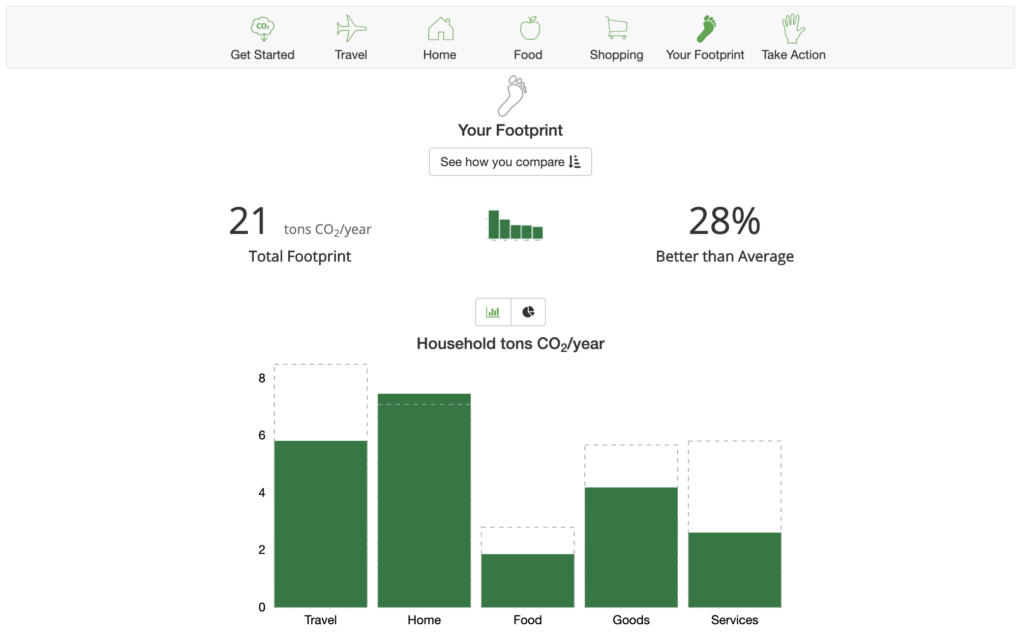The debate over whether climate change is real is over. It just is.
We see more evidence every day of its immediate affects, let alone future ones.
But, we still seem trapped by our own human behavior, our paradox:
Do we wait for government or industry to lead the way, which will take a long, long time? Or, do we rely on personal change, which requires many more people to take action?
Let’s face it, as humans, we are really bad at changing short-term behavior to affect long-term goals.
But, this is a false dichotomy, which actually just leads to inaction.
So, I’m going to issue a challenge to you, dear reader, if you want to see a better world for future generations: take personal action while you demand more of politicians.
I used to calculate my carbon footprint every year and purchase carbon off-sets. This was back when I was the Energy Office Director for the State of Arizona.
Then, for some reason, I stopped. I can’t remember why. Maybe laziness, maybe I just thought we were making faster progress.
But after 13 years, I’ve come back to carbon offsets as a valuable tool.
I realized as I watched a debate on social media that people seem to be waiting for somebody else to tell them what to do.
Of course, then, when some politician suggests that we should pay marginally more through a carbon tax, people’s heads explode for asking them to do something we clearly need to do!
Meanwhile the world generated more carbon than ever in 2019 –when we need to be decreasing our output by at least 8% every year to prevent catastrophic change in the world.
So, I figured that it’s way past due for me to start purchasing carbon offsets again.
Why carbon offsets? Simple. The fastest thing we can do today is to plant more trees. The energy industry is already moving quickly toward renewables, since they are now competitive with or cheaper than natural gas and coal. (Don’t believe me? Just ask the lefties at Forbes Magazine.)
“But, if I’m already struggling financially, how can you ask me to do this?”
I agree. If you can’t afford the entire suggested annual offset, just do what you can.
Step One: Calculate your annual carbon footprint.
I used the Nature Conservancy’s website to calculate my annual carbon footprint. It took me about 10 minutes.
You can find the same calculator at the Arbor Foundation’s website.
I found that I have a carbon footprint of about 21 metric tons per year, and that I’m doing about 28% better than others like me.

Frankly, I thought I was doing better than that.
I have solar panels, drive a Prius and walk wherever I can.
But, at least I have a number to improve upon.
And, anyway, if the world needs to reduce its carbon by about 10% per year, then I do as well, right? Next year, I need to come in under 19 tons.
Step Two: Purchase Carbon Offsets.
First, what is a carbon offset?
Here’s a great definition. For me, the best way to think of it is that I am taking some action that will help undo the carbon emissions that that I generated.
As much as I love solar panels and wind energy, I see that as future carbon avoidance, rather than paying to undo the damage I did over the last year.
So, I believe that the best way to make an immediate difference is to plant as many trees as possible, as quickly as possible. Those eat up carbon as they grow. It’s magic!
Since 1630, the US has destroyed at least 25% of its carbon-eating, virgin forests, and that does not account for the carbon-eating other types of grasslands and environments that we’ve re-purposed. (US Forest Service publication, Pg 7)
So, frankly, I think that estimate is terribly, terribly low.
In short, we can’t wait for politicians (who are either afraid to ask their constituents to pay the true cost of carbon) to do the right thing, or corporations to think long term, or even for our own cultural behavior to change.
The best we can do as individuals is (1) plant more trees now, (2) become more aware of our own personal carbon footprint(s) and (3) demand change from elected officials.
Second, what does it cost?
Well, I was shocked to learn that my 21,000 tons of carbon costs $315 to offset. My jaw dropped.
But, I have to put my money where my mouth is. So, I’m going to contribute monthly to the Arbor Foundation’s carbon offset program.
“So, how can I trust that they are planting the trees?”
Well, the same way that you know that the Heart Association is using your donation wisely. We watch them. Get their reports and read up on websites who research their outcomes.
I’m going to report over the next year. Watch for updates through 2020.

